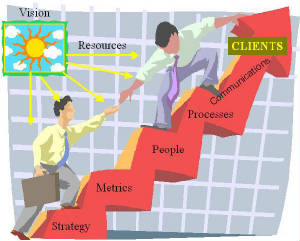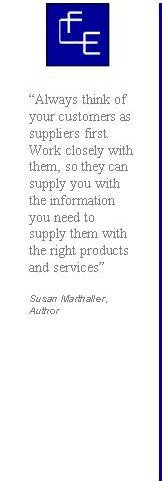|

The generally accepted definition
of a business failure is a situation in which a company ceases to conduct business. Applying this criterium the
Small Business Adminstraton reports 65-70% of all businesses fail within the first five years. While this is a very
high number, it is actually only the tip of the iceberg.
The "ceasing to conduct business" criterium for failure is an interesting one. If failure is ceasing to conduct business, does that
imply that the remaining 30-35% are "successful" just by the fact that they survived for five years? How many of these
survivors hang on by the wits of accountants or by the grace of equally incompetent competition? Are these to be
counted as "successful" businesses?
This narrow definition of failure
actually masks the larger malaise of American business. That malaise
is a disconnect between the company and the customer. It is amazing how little companies invest in understanding and meeting
the needs of their customers. Regardless of all the rhetoric analysts may compose, the difference between a company
that thrives and one that just survives is the level of customer satisfaction it achieves as perceived by the customer.
That is the difference between a Toyota and General Motors. That's the difference between ATT&T and Verizon.
That's the difference between Apple and and Gateway.
One can look at many metrics for measuring success,
such as profitability, market share, stock price etc.etc. However, all of these are lagging indicators and are just
piecemeal reflections of the primary driver of success - Customer Satisfaction.
ISO requirements that went into effect a few
years ago, are drving more and more companies to define success in terms of customer satisfaction. But sadly, the
customer is still largely absent from the mindset of most American board rooms. Until the customer returns, American businesses
will continue to fail in the global contest for steady growth and profitability
Customer Delight - The top of the Customer Satisfaction Pyramid!
The industry leaders in the new millennium will be those that
move beyond customer satisfaction to Customer Delight. Customer Delight is a level of customer satisfaction
at which a company not only consistently exceeds customer expectations but also provides unanticipated benefits or addresses
unexpressed customer needs. Achieving this level requires
studious and continuous commitment to understanding customers and their environment. It means having the tools to capture
and interpret the voice of customers who own, and who have elected not to own, a company's products and services. It means
having the discipline throughout the company to turn that voice of the customer into action in terms of product and service
improvements. It means establishing a corporate culture that challenges and rewards its employees to anctipate customer needs
and not just respond to expectations. Such companies will make headlines every now and then with "breakthroughs" . However
their modus operandi is more of consistently distancing themselves from the competition through the accumulation of incremental
improvements. Just consistently and silently getting better and better. Companies like Toyota, Lowes, Google, and Bose
Corporation are indicative of those who are operating at the "Customer Delight" level.
If you are interested in a more expansive treatment of what it takes to become a company
that consistently delights its customers, I strongly recommend Richard Whiteley's, The Customer Driven Company.
In particular, Chapter Six of this book has an excellent discourse on measuring customer satisfaction.

Customer Focus Engineering
508.494.5682
http://www.cfengineer.com
|
